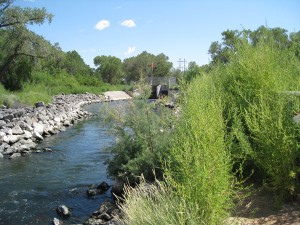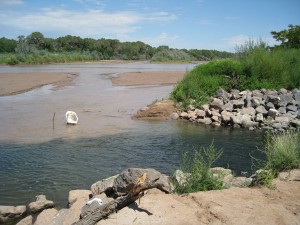It’s been called the largest tributary in New Mexico’s middle Rio Grande – the outfall from Albuquerque’s sewage treatment plant.
A friend loaned me his mountain bike for the weekend (I’m in the market for a new bike that I can ride off the pavement), so I took it for a test ride down in Albuquerque’s south valley, where the sewage treatment plant discharges our cleaned up water into the Rio Grande.
I’ve never run the numbers, so I can’t say this with publication-quality authority, but it’s frequently said that it discharges more water annually into the Rio Grande than any natural stream between Otowi and Elephant Butte Reservoir – the stretch we call the “middle Rio Grande.” In round numbers, Albuquerque withdraws about 100,000 acre feet of water per year, consuming about half of it and discharging the rest into the Rio Grande here. Given that the major drainages between Otowi and the Butte are largely ephemeral, flowing primarily during flash floods, I’ve got no reason to doubt the “biggest tributary in the middle Rio Grande” thing.
The water has a bit of a musty smell, and comes out crystal clear, poking out into the Rio Grande before it quickly mixes in with the river’s muddy main stem.
By my back-of-the-envelop calculation, the treatment plant’s contribution this time of year is upwards of 10 percent of the river’s flow downstream from this point.
This has been on my mind because I’ve been following George Janczyn’s discussion of San Diego’s Indirect Potable Reuse project. It’s a test of cleaning up some of San Diego’s sewage and returning it to the water system. In arid lands, this seems to me like a no-brainer. Clean the water up and find a way to put it back into the system so it can be used again. In our case, the water is used by irrigators downstream of Albuquerque, ultimately ending up in Elephant Butte Reservoir and on to water users to the south.
Until recently, Albuquerque’s water came from pumped groundwater. In the long run, that has the effect of depleting the river, gallon for gallon, as water leaks out of the riparian system to fill the holes being created by our pumps’ great sucking. But in the shorter term, it has had the effect of a sort of water subsidy for the Rio Grande.
Here, the return flow issue makes for some complicated water policy discussions because of a common misunderstanding of what our net water supply really is. For every 100 gallons we withdraw from the system (from groundwater or the river), we’re putting 50 gallons back into the system where others can use it, so our net consumptive use is just 50 gallons. There are two types of efficiencies we can implement. One type would involve, for example, reducing outdoor watering. A gallon of outdoor watering is entirely consumptive, so saving that gallon by tearing up a piece of lawn saves a gallon of net consumptive use. That gallon never had a chance to get back to the river.
Saving a gallon by installing a low-water toilet is different. If it uses a gallon less per flush, that means one less gallon withdrawn from the system in the first place, as well as one less gallon returned to the river. The effect on our net consumptive use is effectively zero. There are good reasons to do the low-flow toilet anyway – energy consumption in pumping and treating the water, line losses, etc. But things like low-flow toilets and other indoor water efficiencies don’t save as much water, in terms of our overall water budget, as people often think.
If, on the other hand, you’re discharging the effluent from your sewage treatment plant into the ocean, as I understand San Diego does it (So I have this right, George?), then both indoor conservation and things like IPR are, as I said, no-brainers.
In addition to the water math, there were some positive externalities today as a result of our sewage plant return flow, in the form of a trio of lesser yellowlegs poking around in the mud.



Hi John –
Yes, San Diego discharges most of its sewage into the ocean after “advanced primary” treatment – an average of 150mgd via a 4-mile long outfall pipe.
In addition we have two water reclamation plants that combined can produce 45mgd of tertiary water which is now sold for irrigation and industrial use.
San Diego’s IPR project will take some tertiary water and give it advanced treatment to potable standards and blend it with raw imported water. It’s in a feasibility study right now, but if approved would produce 16mgd of purified water.
This would be called “planned indirect potable reuse.”
I can’t tell from your description of Albuquerque but it doesn’t sound like tertiary plus advanced treatment is done. Anyway, it’s not uncommon for cities to release effluent into waterways that other communities downtream will use for water. That’s called “unplanned indirect potable reuse.”
John, great piece and photos. How would I find this place? Is it directly near the South Valley sewage treatment facility along the bosque trail or is it further downstream?
“A gallon of outdoor watering is entirely consumptive”
No, not if some of THAT either runs off or sinks into groundwater…
David – You’re correct, but in Albuquerque neither runoff back to the river nor groundwater recharge occurs to any significant degree.
Don –
It’s on the east side of the river south of Rio Bravo. You go down the dirt levee road a bit more than half a mile. You can’t get to it from the paved bike trail because of the ditch:
http://maps.google.com/maps/ms?ie=UTF8&hl=en&msa=0&ll=35.017345,-106.671495&spn=0.032686,0.05785&t=h&z=14&msid=114172083179050868277.00048df229871a3a980e9
John:
You’re correct about the contribution of the Southside Water Reclamation Plant’s discharge – it is the 3rd largest tributary to the Rio Grande at 62,000 AF/yr. The order of tributaries is (30 year average flows):
Rio Chama – 413,000 AF/yr
Conejos River – 67,000 AF/yr
SWRP Discharge – 62,000 AF/yr
Jemez River – 43,100 AF/yr
The SWRP discharge is also a great place for birdwatching on cold winter mornings when water fowl and shorebirds congregate to bask in its relatively warm water.
-Bruce Thomson
As a point of interest. Does the USGS (or anyone else) maintain a gage there?
dg
DG – The Water Utility Authority has gages of some sort inside the two outflow pipes as they leave the treatment plant, about 50 meters or so from where the pictures were taken. They report the data to our Office of State Engineer for return flow accounting purposes.
This is good stuff, John.
Pardon my ignorance, but I’m still a bit confused. I understand that the water from the sewage treatment plant has been treated (that is, I know it is not dumping raw sewage into the RG). But what exactly does this mean? Is the water distilled? Are there some impurities that are not eliminated during the treatment process? If so, do they matter in important ways?
I suppose I’m just wondering what the environmental impact is of this water entering the RG – if it is warmer, does this potentially contribute to some negative effects (i.e. algal bloom)? Does the clean water dilute the main tributary in ways that are potentially harmful?
Signed,
a former surfer chick who spent mucho time watching the warm water from the Dolly Parton Monument in San Onofre enter the Pacific.
BB – That’s a great question, and I’m embarrassed I don’t know the answer. I’ll poke around a bit and then write a post (probably over on the newspaper site). I’ll send you an email when I do it.
Good story John, I have been watching this situation here in Albuquerque for years now. Not in the far distance future recycling for potable water will be the norm. As far as San Diego and Arizona, I think there will be a mass migration north to where people can find water. As India is building walls to keep Pakistan and Bangladesh migrants out of their country due to the monsoonal catastrophe caused by climate change, so will we see the issues of migration here in the U.S. change, with the increase moisture and the displacement of hydrological system changes, downpours and drought, our changing Earth. I understand we soon will have a new name for our planet…eearth! ( i bet you thought there would be another name for it!) Mars, Venus or something in between.
I checked Albuquerque’s wastewater treatment plant’s website. It doesn’t specifically say how the wastewater is treated, although my take is that it is secondary treatment because there are many references to being in compliance with EPA requirements and EPA requires secondary treatment. Also there’s this page on the city’s website: http://www.cabq.gov/progress/public-infrastructure/dcc-18
The San Diego project, by contrast, would treat to tertiary level, then provide advanced purification techniques to make the water virtually like distilled water before mixing it with the raw water supply.
As for @Elaine’s comment, the idea of a migration from my area because of water certainly sounds plausible to me, though I hope it will happen in a gradual way as awareness grows and not because of a sudden disaster.
Congratulations John: Perhaps now everyone will realize that the outfall from the treatment plant is but one volume of tailwater that flows back to the RG after a user has used it. So after everyone uses their water along the RG from its origins in Colorado to San Marcial what has been returned to the river and flows past San Marcial is TAILWATER to the entire upstream. It is native Rio Grande Water (Except for the San Juan Chama water) and according to the NM Constitution it is in the public domain and available for appropriation. So, realizing this, when the State Engineer tried to do an end run around the Constitution by foisting the fiction that credit water under the RG Compact in Elephant Butte belonged to the Interstate Stream Commission (that fictional agency staffed by State Engineer employees and whose budget is within the SE budget, and whose offices are in SE office buildings, and whose website is on the SE website)I filed a Notice of Intention to Appropriate it. The Notice is the first step in appropriating water. So anyone who wants to secure use of that credit water please contact me and we will begin filing applications for it. Remember, the Rio Grande Compact on allocates water between reaches of the Rio Grande. It says nothing about ownership. Call me at 505-843-7643
Pingback: Stuff I Wrote Elsewhere: Diversions, Consumptive Use and those Pesky Return flows : jfleck at inkstain